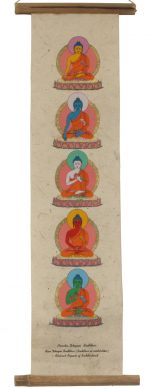
 Cinco Famílias Búdicas (Skt. pañcakula; Tib. རིགས་ལྔ་, rik nga’, Wyl. rigs lnga) —
Cinco Famílias Búdicas (Skt. pañcakula; Tib. རིགས་ལྔ་, rik nga’, Wyl. rigs lnga) —
- Família buddha (Skt. tathāgatakula)
- Família vajra (Skt. vajrakula)
- Família ratna (Skt. ratnakula)
- Família padma ou família lótus (Skt. padmakula)
- Família karma (Skt. karmakula)
| Diagrama das Cinco Famílias de Buda [1] | |||||
| família | Buda | vajra | ratna | padma | carma |
| direção | Centro | leste | sul | oeste | norte |
| cor | azul | branco | amarelo | vermelho | verde |
| símbolo da família | roda do dharma | vajra | ratna | lótus | dorje duplo |
| Buda masculino [2] | Vairochana [3] | Vajrasattva – Akshobhya [4] | Ratnasambhava | Amitabha | Amoghasiddhi |
| sabedoria [5] | sabedoria de dharmadhatu | sabedoria semelhante a um espelho | sabedoria da igualdade | sabedoria do discernimento | Sabedoria de todos os êxitos |
| veneno [6] | ilusão ou ignorância | raiva | orgulho | desejo | ciúmes |
| skhanda [7] | Formato | consciência | sentindo-me | percepção | formações |
| Buda feminino [8] | Dhatvishvari | Buddhalochana ou Mamaki | Mamaki ou Lochana | Pandaravasini | Samayatara |
| elemento [9] | espaço | agua | terra | fogo | ar |
Referência:
http://www.rigpawiki.org/index.php?title=Five_buddha_families
Notes
- Version based on the Nyingma, inner tantras
- each family is associated with one of the buddhas of the five families
- in the Sarma tantras, Akshobhya is often at the centre of the mandala, instead of Vairochana
- in the Sarma tantras, Vairochana is often in the eastern direction, instead of Akshobhya
- each buddha is associated to one of the five wisdoms
- each wisdom is a transmutation of one of the five poisons
- Jump up↑ each buddha is associated to one of the five skandhas
- in union with each of the five buddhas
- each female buddha represents the purity of one of the five elements





 Cintamani - Meditação e Arte - Copyright 2020 - Todos os direitos reservados.
Cintamani - Meditação e Arte - Copyright 2020 - Todos os direitos reservados.